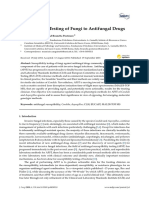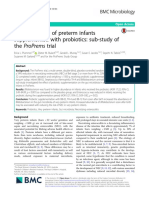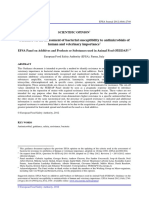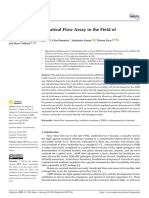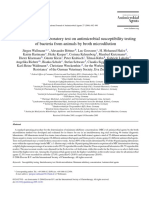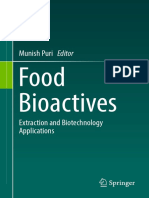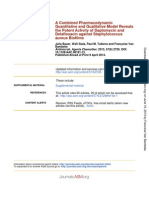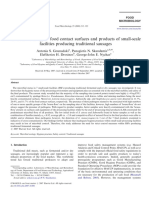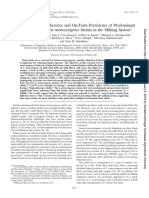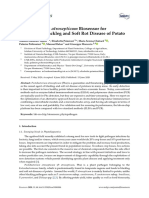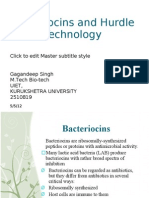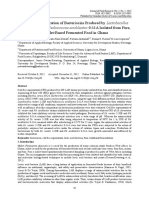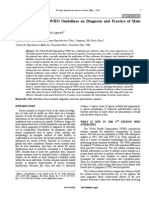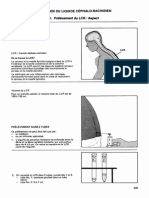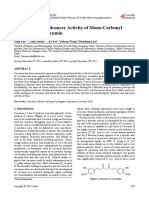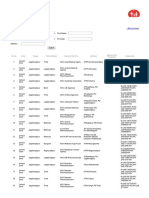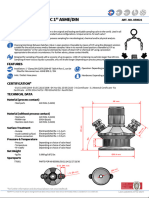Antimicrob. Agents Chemother. 2010 Huys 2567 74
Antimicrob. Agents Chemother. 2010 Huys 2567 74
Uploaded by
mostecocCopyright:
Available Formats
Antimicrob. Agents Chemother. 2010 Huys 2567 74
Antimicrob. Agents Chemother. 2010 Huys 2567 74
Uploaded by
mostecocCopyright
Available Formats
Share this document
Did you find this document useful?
Is this content inappropriate?
Copyright:
Available Formats
Antimicrob. Agents Chemother. 2010 Huys 2567 74
Antimicrob. Agents Chemother. 2010 Huys 2567 74
Uploaded by
mostecocCopyright:
Available Formats
Published Ahead of Print 12 April 2010.
10.1128/AAC.00407-10.
2010, 54(6):2567. DOI: Antimicrob. Agents Chemother.
Egervrn, Mauro Giacomini and Peter Vandamme
Lars Axelsson, Jenni Korhonen, Sigrid Mayrhofer, Maria
Tosi, Morten Danielsen, Ana Beln Flrez, Jaana Mtt,
Geert Huys, Klaas D'Haene, Margo Cnockaert, Lorenzo
Acid Bacteria
Bifidobacteria and Nonenterococcal Lactic
Susceptibility Testing Methods for
Two Commercial Antimicrobial
Intra- and Interlaboratory Performances of
http://aac.asm.org/content/54/6/2567
Updated information and services can be found at:
These include:
SUPPLEMENTAL MATERIAL
Supplemental material
REFERENCES
http://aac.asm.org/content/54/6/2567#ref-list-1 at:
This article cites 34 articles, 11 of which can be accessed free
CONTENT ALERTS
more articles cite this article),
Receive: RSS Feeds, eTOCs, free email alerts (when new
http://journals.asm.org/site/misc/reprints.xhtml Information about commercial reprint orders:
http://journals.asm.org/site/subscriptions/ To subscribe to to another ASM Journal go to:
o
n
O
c
t
o
b
e
r
1
7
,
2
0
1
3
b
y
g
u
e
s
t
h
t
t
p
:
/
/
a
a
c
.
a
s
m
.
o
r
g
/
D
o
w
n
l
o
a
d
e
d
f
r
o
m
o
n
O
c
t
o
b
e
r
1
7
,
2
0
1
3
b
y
g
u
e
s
t
h
t
t
p
:
/
/
a
a
c
.
a
s
m
.
o
r
g
/
D
o
w
n
l
o
a
d
e
d
f
r
o
m
o
n
O
c
t
o
b
e
r
1
7
,
2
0
1
3
b
y
g
u
e
s
t
h
t
t
p
:
/
/
a
a
c
.
a
s
m
.
o
r
g
/
D
o
w
n
l
o
a
d
e
d
f
r
o
m
o
n
O
c
t
o
b
e
r
1
7
,
2
0
1
3
b
y
g
u
e
s
t
h
t
t
p
:
/
/
a
a
c
.
a
s
m
.
o
r
g
/
D
o
w
n
l
o
a
d
e
d
f
r
o
m
o
n
O
c
t
o
b
e
r
1
7
,
2
0
1
3
b
y
g
u
e
s
t
h
t
t
p
:
/
/
a
a
c
.
a
s
m
.
o
r
g
/
D
o
w
n
l
o
a
d
e
d
f
r
o
m
o
n
O
c
t
o
b
e
r
1
7
,
2
0
1
3
b
y
g
u
e
s
t
h
t
t
p
:
/
/
a
a
c
.
a
s
m
.
o
r
g
/
D
o
w
n
l
o
a
d
e
d
f
r
o
m
o
n
O
c
t
o
b
e
r
1
7
,
2
0
1
3
b
y
g
u
e
s
t
h
t
t
p
:
/
/
a
a
c
.
a
s
m
.
o
r
g
/
D
o
w
n
l
o
a
d
e
d
f
r
o
m
o
n
O
c
t
o
b
e
r
1
7
,
2
0
1
3
b
y
g
u
e
s
t
h
t
t
p
:
/
/
a
a
c
.
a
s
m
.
o
r
g
/
D
o
w
n
l
o
a
d
e
d
f
r
o
m
o
n
O
c
t
o
b
e
r
1
7
,
2
0
1
3
b
y
g
u
e
s
t
h
t
t
p
:
/
/
a
a
c
.
a
s
m
.
o
r
g
/
D
o
w
n
l
o
a
d
e
d
f
r
o
m
ANTIMICROBIAL AGENTS AND CHEMOTHERAPY, June 2010, p. 25672574 Vol. 54, No. 6
0066-4804/10/$12.00 doi:10.1128/AAC.00407-10
Copyright 2010, American Society for Microbiology. All Rights Reserved.
Intra- and Interlaboratory Performances of Two Commercial
Antimicrobial Susceptibility Testing Methods for Bidobacteria
and Nonenterococcal Lactic Acid Bacteria
Geert Huys,
1,2
* Klaas DHaene,
2
Margo Cnockaert,
2
Lorenzo Tosi,
3
Morten Danielsen,
4
Ana Bele n Florez,
5
Jaana Ma tto,
6
Lars Axelsson,
7
Jenni Korhonen,
8
Sigrid Mayrhofer,
9
Maria Egerva rn,
10
Mauro Giacomini,
11
and Peter Vandamme
2
BCCM/LMG Bacteria Collection
1
and Laboratory of Microbiology,
2
Department of Biochemistry and Microbiology, Faculty of
Sciences, Ghent University, B-9000 Ghent, Belgium; Istituto di Microbiologia, Universita Cattolica del Sacro CuorePiacenza,
Piacenza, Italy
3
; Chr. Hansen A/S, Boege Alle 10-12, Hoersholm, Denmark
4
; Instituto de Productos Lacteos de Asturias (IPLA),
CSIC, Carretera de Inesto s/n, Villaviciosa, Asturias, Spain
5
; VTT, Technical Research Centre of Finland, Espoo, Finland
6
;
Noma Mat AS, As, Norway
7
; Department of Biosciences, Nutrition and Food Biotechnology, University of Kuopio, Kuopio,
Finland
8
; Department of Food Science and Technology, University of Natural Resources and Applied Life Sciences-BOKU,
Vienna, Austria
9
; Microbiology Division, Research and Development, National Food Administration,
Uppsala, Sweden
10
; and DIST, University of Genova, Genoa, Italy
11
Received 26 March 2010/Accepted 2 April 2010
In a small-scale harmonization study involving nine laboratories in eight European countries, the intra- and
interlaboratory performances of two commercially available systems, i.e., the VetMIC microplate system and
Etest, for antimicrobial susceptibility testing of nonenterococcal lactic acid bacteria (NELAB) and bidobac-
teria were analyzed. In addition, one laboratory also performed standard broth microdilution as a reference
method. MICs of tetracycline, erythromycin, ampicillin, gentamicin, clindamycin, and streptomycin for the
type strains of 25 species of NELAB and bidobacteria and MICs of vancomycin for a selection of relevant taxa
were determined. The previously described lactic acid bacterium susceptibility test medium (LSM) and related
mixed-medium formulations, all including Iso-Sensitest broth as a basic component, were used as test media.
The overall agreement of median MIC ranges 1 log
2
dilution determined by the VetMIC and Etest methods
with the median MICs determined by the reference method was very good for tetracycline, ampicillin, and
streptomycin (92.3 to 100%) but low for erythromycin (19.5 to 30.7%) and clindamycin (50.0 to 80.8%). There
was a consensus among the participating laboratories that VetMIC was preferred over Etest because of its
lower cost, better growth support, and more uniform criteria for MIC end point reading. With the range for
acceptable intralaboratory reproducibility being dened as the median MIC 1 log
2
dilution, VetMIC results
(with 69.2% of all data sets in the acceptable range) were shown to display greater reproducibility than Etest
results (with 58.8% of all data sets in the acceptable range). Also at the interlaboratory level, the proportion
of MIC values obtained with VetMIC that belonged to the complete agreement category (60.0%) was higher
than the proportion of such values obtained with Etest (47.0%), which indicates a higher degree of interlabo-
ratory reproducibility for the former method. Apart from some agent-specic effects, the majority of VetMIC
and Etest replicate data sets were situated within a 1- to 2-log
2
dilution range, suggesting that the two methods
can be considered to be equivalent for recognizing resistance phenotypes. This multicenter study has further
validated the standard use of LSM and related mixed-medium formulations with commercially available
systems and formed the basis for the ongoing development of the ISO 10932/IDF 223 standard for susceptibility
testing of NELAB and bidobacteria.
Because of their distinctive fermentative, functional, and
potentially health-promoting properties, bidobacteria and
nonenterococcal lactic acid bacteria (NELAB) such as lacto-
bacilli, lactococci, and Streptococcus thermophilus are inten-
sively used in the food industry as starter cultures, adjunct
cultures, and probiotics (29). Although the majority of NELAB
and Bidobacterium species are food-grade organisms, the
large-scale application and deliberate introduction of such cul-
tures into the food chain has opened the debate over whether
or not criteria that document their safety for human and ani-
mal use should be dened (35). Despite the overall low patho-
genic potential of these organisms, several studies have indi-
cated that especially NELAB can act as reservoirs of
potentially transferable antimicrobial resistance genes (1, 10,
15, 31). In the eld of probiotics, the absence of acquired
resistance traits has been recommended as a safety criterion in
the selection of new commercial culture probiotic strains for
human use (12, 27, 28, 33).
Due mainly to the limited clinical relevance of NELAB and
bidobacteria, the development and optimization of methods
for antimicrobial susceptibility testing of these organisms have
long been underappreciated. Moreover, the fact that many of
these organisms have specic nutritional and atmospheric re-
* Corresponding author. Mailing address: Laboratory of Microbiol-
ogy, Ghent University, K.L. Ledeganckstraat 35, B-9000 Ghent, Bel-
gium. Phone: 32-9-2645131. Fax: 32-9-2645092. E-mail: Geert.huys
@UGent.be.
Supplemental material for this article may be found at http://aac
.asm.org/.
Published ahead of print on 12 April 2010.
2567
quirements for growth does not allow uniform use of standard-
ized susceptibility test media such as Mueller-Hinton broth
and Iso-Sensitest (IST) broth. There are indications that de
Man, Rogosa, and Sharpe (MRS) medium, which is commonly
used as a growth medium for most of these organisms, may
exhibit antagonistic effects with supplemental antimicrobials in
susceptibility testing (13). To address the apparent limitations
of using single media, a mixed formulation of IST broth (90%,
vol/vol) and MRS broth (10%, vol/vol) referred to as lactic acid
bacterium susceptibility test medium (LSM) was developed
recently (16). This new formulation has proven to support the
growth of a wide taxonomic range of lactobacilli and Bidobac-
terium spp. (when supplemented with 0.03% cysteine) and
minimizes potential antagonism between medium components
and tested antimicrobials. So far, LSM and related mixed-
medium formulations, all containing IST broth as the basic
component, have been successfully used to determine MICs
for members of the genera Bidobacterium, Lactobacillus, Lac-
tococcus, Pediococcus, and Streptococcus by microdilution and
Etest methods (2, 5, 7, 8, 17, 18, 2024, 32).
In the near future, it is expected that the increased use
of LSM as the standard medium for susceptibility testing of
NELAB and bidobacteria will produce a large amount of
MIC data, enabling the denition of epidemiological cutoffs
(ECOFFS). As proposed by the European Committee on
Antimicrobial Susceptibility Testing (EUCAST [http://www
.eucast.org/]), ECOFFS provide an objective basis to differen-
tiate wild-type organisms, which lack acquired and mutational
resistance mechanisms, from non-wild-type members of the
same species that contain one or more mechanisms conferring
antimicrobial resistance. For this purpose, evaluation of the
internal and external quality assurance procedures for refer-
ence methods and commercial systems for susceptibility testing
is absolutely crucial for the correct interpretation of these
ECOFFS. Several harmonization studies of susceptibility test-
ing of clinical (14, 30), veterinary (26, 34), and aquatic (11, 25)
organisms have provided important insights into the reproduc-
ibility of results from standardized methods at the intra- and/or
interlaboratory level. Although such studies would also be
highly valuable to all with an interest in evidence-based bio-
safety assessments of NELAB and bidobacteria for human
and animal use, the performances of susceptibility test meth-
ods using LSM within and across laboratories have to our
knowledge not been evaluated.
Within the framework of an international research project,
the European Union Assessment and Critical Evaluation of
Antibiotic Resistance Transferability in Food Chain (EU-
ACE-ART), a small-scale harmonization study involving nine
laboratories in eight European countries was conducted. The
study set out to examine the performances of two commercial
susceptibility test methods widely used throughout the EU-
ACE-ART project, i.e., the VetMIC system (broth microdilu-
tion) and Etest (agar diffusion), at the intra- and interlabora-
tory levels. For this purpose, MICs of six antimicrobials for the
type strains of 25 NELAB and Bidobacterium species and
MICs of vancomycin for a selection of relevant taxa were
determined using LSM and related mixed-medium formula-
tions as test media.
MATERIALS AND METHODS
Study design and culture conditions. Susceptibility testing by VetMIC and
Etest systems was performed according to standard operating procedures (SOPs)
that were approved by all nine participants in the harmonization study: Labora-
tory of Microbiology, Ghent University, Ghent, Belgium; Istituto di Microbio-
logia, Universita Cattolica del Sacro CuorePiacenza, Piacenza, Italy; Chr.
Hansen A/S, Hoersholm, Denmark; Instituto de Productos La cteos de Asturias,
Villaviciosa, Asturias, Spain; VTT Biotechnology, Espoo, Finland; Noma Mat
AS (previously Matforsk AS), As, Norway; University of Kuopio, Kuopio, Fin-
land; Department of Food Science and Technology, University of Natural Re-
sources and Applied Life Sciences, Vienna, Austria; and Institution of Microbi-
ology, Research and Development, National Food Administration, Uppsala,
Sweden. In addition to taking part in the interlaboratory harmonization study,
one participant also determined the MICs for all strain-antimicrobial combina-
tions (except those with vancomycin) by a noncommercial reference method
based on the use of fresh broth microdilution panels.
The test panel comprised the type strains of 18 NELAB and 7 Bidobacterium
species and Enterococcus faecalis ATCC 29212 (LMG 8222) obtained from the
BCCM/LMG Bacteria Collection, Ghent University, Ghent, Belgium (http:
//bccm.belspo.be/about/lmg.php) (Table 1). The strains were distributed to the
respective participating laboratories as lyophilized cultures. Upon arrival in the
labs, cultures were recovered on MRS medium and maintained on cryobeads
during the entire study. Each strain was tested in three different laboratories
using VetMIC and Etest and in a single laboratory using a broth microdilution
reference method. Per strain-antimicrobial combination tested with VetMIC and
Etest, each participating laboratory had to conduct a series of ve independent
consecutive replications starting from new subcultures. For combinations tested
with the broth microdilution reference method, four consecutive replications
were conducted.
Prior to the actual susceptibility assay, strains were precultured overnight (16
to 24 h, except for bidobacteria, which usually required 40 to 48 h) on the agar
version of the test medium under the recommended incubation conditions (Ta-
ble 1). For lactobacilli, the LSM formulation (i.e., 90% IST broth [code no.
TABLE 1. Growth conditions for antimicrobial susceptibility testing
of NELAB and Bidobacterium type strains
a
Strain Medium
Temp
(C)
B. adolescentis LMG 10502
T
LSM-cysteine 37
B. animalis subsp. animalis LMG 10508
T
LSM-cysteine 37
B. bidum LMG 11041
T
LSM-cysteine 37
B. breve LMG 13208
T
LSM-cysteine 37
B. longum subsp. longum LMG 13197
T
LSM-cysteine 37
B. pseudolongum subsp. pseudolongum
LMG 11571
T
LSM-cysteine 37
B. thermophilum LMG 21813
T
LSM-cysteine 37
E. faecalis LMG 8222 IST broth 37
Lb. acidophilus LMG 9433
T
LSM 37
Lb. amylovorus LMG 9496
T
LSM 37
Lb. brevis LMG 6906
T
LSM 28
Lb. casei LMG 6904
T
LSM 28
Lb. delbrueckii subsp. bulgaricus LMG
6901
T
LSM 37
Lb. fermentum LMG 6902
T
LSM 37
Lb. gasseri LMG 9203
T
LSM 37
Lb. helveticus LMG 6413
T
LSM 37
Lb. johnsonii LMG 9436
T
LSM 37
Lb. paracasei subsp. paracasei LMG 13087
T
LSM 28
Lb. pentosus LMG 10755
T
LSM 28
Lb. plantarum LMG 6907
T
LSM 28
Lb. reuteri LMG 9213
T
LSM 37
Lb. rhamnosus LMG 6400
T
LSM 37
Lb. sakei subsp. carnosus LMG 17302
T
LSM 28
Lb. sakei subsp. sakei LMG 9468
T
LSM 28
Lc. lactis subsp. lactis LMG 6890
T
IST broth 32
S. thermophilus LMG 6896
T
IST-M17-lactose 42
a
All strains were grown under anaerobic conditions. LMG strains were ob-
tained from the BCCM/LMG Bacteria Collection, Ghent University, Ghent,
Belgium.
2568 HUYS ET AL. ANTIMICROB. AGENTS CHEMOTHER.
CM0471; Oxoid], 10% MRS broth [code no. CM0359; Oxoid]) was used, whereas
for bidobacteria, LSM broth was supplemented with 0.3 g/liter l-cysteineHCl
(yielding a formulation hereinafter referred to as LSM-cysteine). The pHs of
LSM and LSM-cysteine were adjusted to 6.7 after autoclaving of the prepara-
tions with sterile HCl solution (16). For S. thermophilus, IST broth (90%) was
supplemented with M17 broth (10% [code no. CM0817; Oxoid]) and 1% lter-
sterilized lactose (yielding a formulation hereinafter referred to as IST-M17-
lactose) (32). Pure IST broth was used for Lactococcus lactis subsp. lactis. In
Etest assays, agar versions (Oxoid) of the respective broth media were used,
except for MRS broth, which was supplemented with 15 g/liter bacteriological
agar no. 1 (code no. LP0011; Oxoid).
VetMIC assay. After overnight incubation, agar cultures were checked for
purity. For inoculum preparation, individual colonies were suspended in a sterile
glass or plastic culture tube containing 2 to 5 ml sterile saline (i.e., 0.85% NaCl
solution) until a density corresponding to a McFarland (McF) standard of 1 or
a spectrophotometric equivalent (3 10
8
CFU/ml) was obtained. The inoculated
saline suspension was diluted 1:1,000 (for inoculation of VetMIC plates) or 1:500
(for inoculation of vancomycin microdilution plates) in the appropriate test
medium (Table 1) to obtain a nal concentration of 3 10
5
or 6 10
5
CFU/ml,
respectively, as recommended previously (6).
VetMIC (National Veterinary Institute, Uppsala, Sweden [http://www.sva.se
/en/Target-navigation/ServicesProducts/VetMIC/]) is a commercially available
microtiter-based system comprising dried antimicrobials in serial 2-fold dilutions
that can be stored for 2 years at room temperature. For the ACE-ART project,
a tailor-made VetMIC plate was designed, enabling susceptibility testing of two
strains per plate for the following six agents: tetracycline (0.5 to 128 g/ml),
erythromycin (0.12 to 16 g/ml), streptomycin (2 to 256 g/ml), gentamicin (0.5
to 32 g/ml), clindamycin (0.12 to 8 g/ml), and ampicillin (0.12 to 8 g/ml).
Susceptibility to vancomycin was tested in a separate broth microdilution assay
for bidobacteria and for members of the Lactobacillus acidophilus group, i.e.,
Lb. acidophilus, Lb. amylovorus, Lb. johnsonii, and Lb. gasseri.
One hundred microliters of the 3 10
5
CFU/ml inoculum was added to each
well (yielding 3 10
4
CFU/well) in columns 1 to 6 (strain 1) or 7 to 12 (strain
2) of individual VetMIC plates within 30 min after the preparation of the
standardized inoculum. According to the VetMIC manufacturer, no additional
homogenization step was required because the antimicrobial compound in each
well dissolves easily in the test medium and diffuses to achieve equilibrium
throughout the well. Microplates were incubated under the species-specic con-
ditions listed in Table 1. When anaerobic jars were used, plates were piled with
a lid between every two plates to generate a homogeneous environment through-
out the jar. Depending on whether the tests were performed at 28 or 37C, Lb.
plantarum ATCC 14917
T
(LMG 6907
T
) or E. faecalis ATCC 29212, respectively,
was included as a control strain during each susceptibility assay. As positive and
negative controls, a standardized inoculum and uninoculated test medium, re-
spectively, were added to wells without an antimicrobial compound.
For vancomycin microdilution assays, a stock solution of 1,280 g/ml vanco-
mycin (product no. V2002; Sigma) in water was prepared, and samples of this
solution were diluted in LSM broth (for members of the Lb. acidophilus group)
or LSM-cysteine (for bidobacteria) to obtain intermediate concentrations over
the range from 0.25 to 256 g/ml. Subsequently, 50-l aliquots of the nal
solutions were dispensed into microdilution plates, which were then sealed in
plastic bags and immediately frozen at or below 20C until needed. Upon
usage, plates were thawed under anaerobic conditions. Each well containing 50
l of a serial vancomycin dilution was inoculated with 50 l of the bacterial
inoculum (6 10
5
CFU/ml of LSM broth [for members of the Lb. acidophilus
group] or LSM-cysteine [for bidobacteria]), resulting in a nal bacterial con-
centration of 3 10
5
CFU/ml (3 10
4
CFU/well) and in a nal antibiotic
concentration of 0.12 to 128 g/ml. The last row in each plate was used as a
sterility control and was inoculated with pure LSM broth or LSM-cysteine. The
same control strains used for VetMIC plates were used.
After 48 h of incubation, growth in VetMIC and vancomycin microdilution
assay systems was evaluated visually by comparing the pellet at the bottom of a
well with the positive and negative controls. Any series of wells in which discon-
tinuity in growth was observed were discarded. Irrespective of the bactericidal or
bacteriostatic mechanism of the tested agent, the MIC was dened as the lowest
antimicrobial concentration for which at least 80% visual reduction in growth
was reported.
Etest. Strain inocula with densities corresponding to a McF standard of 1 or a
spectrophotometric equivalent (3 10
8
CFU/ml) were prepared as described
above. A sterile cotton swab was dipped into the standardized inoculum and used
to inoculate an agar plate of the appropriate test medium (Table 1). Inoculated
plates were allowed to dry for approximately 15 min before application of the
Etest (AB bioMe rieux, Solna, Sweden) and incubated under the recommended
conditions (Table 1). Etest strips with preformed antimicrobial gradients in the
test range from 0.016 to 256 g/ml were applied for tetracycline (article no. 5100
2258; AB Biodisk), erythromycin (article no. 5100 1058; AB Biodisk), strepto-
mycin (article no. 5100 2188; AB Biodisk), gentamicin (article no. 5100 1258; AB
Biodisk), clindamycin (article no. 5100 0958; AB Biodisk), ampicillin (article no.
5100 0158; AB Biodisk), and (for members of the Lb. acidophilus group and
Bidobacterium spp.) vancomycin (article no. 5100 2558; AB Biodisk).
After 48 h of incubation, the MIC was dened as the value corresponding to
the rst point on the Etest strip where growth did not occur along the inhibition
ellipse. For bacteriostatic agents (e.g., tetracycline, erythromycin, and clindamy-
cin), the MIC was read at the point where growth was inhibited by 80% (i.e., the
rst point of signicant inhibition as judged by the naked eye).
Broth microdilution reference assay. Cultures at a McF standard of 1 were
prepared as described for the VetMIC assay. The resulting saline culture sus-
pension was diluted 1:500 in the appropriate test medium (Table 1) to obtain a
nal concentration of 6 10
5
CFU/ml.
The MICs of the following antimicrobial agents were determined: tetracycline
(range, 0.5 to 128 g/ml [product no. T3383; Sigma]), erythromycin (range, 0.12
to 16 g/ml [product no. E5389; Sigma]), streptomycin (range, 2 to 256 g/ml
[product no. S6501; Sigma]), gentamicin (range, 0.5 to 32 g/ml [product no.
G1264; Sigma]), clindamycin (range, 0.12 to 8 g/ml [product no. C5269;
Sigma]), and ampicillin (range, 0.12 to 8 g/ml [product no. A0166; Sigma]). For
each agent, two freshly prepared sterile stock solutions were diluted in the
appropriate test medium to obtain 2-fold dilution series, each encompassing a
range of four concentrations. Each well containing 50 l of a serial antibiotic
dilution was inoculated with 50 l of the bacterial inoculum (6 10
5
CFU/ml of
the appropriate broth), resulting in a nal bacterial concentration of 3 10
5
CFU/ml (3 10
4
CFU/well). The last row in each plate was used as a sterility
control and was inoculated with pure broth. The control strains were the same
used for the other assays. After 48 h of incubation, MICs were determined as
described for the VetMIC assay.
Data processing and statistical analysis. For each participating laboratory,
MIC data and remarks on end point reading were led in a standard table format
and sent to a central laboratory, where they were collected in a central database.
For evaluation of intralaboratory reproducibility, MIC data generated with
VetMIC and Etest were rst converted to log
2
values. In the case of Etest
readings, MIC data that ranked in between 2-fold dilutions were rounded up to
the next 2-fold dilution before conversion to the log
2
scale. For each series of ve
replicate MIC measurements for a specic strain-antimicrobial combination, the
median of the log
2
series and the log
2
value of the median were determined.
Finally, the mathematical differences between each of the ve log
2
values in the
replicate series and the log
2
value of the median were summed. Analysis of these
summed log
2
distances (SLD) across all strain-antimicrobial combinations al-
lowed classication of the variations in MIC data from the individual participat-
ing laboratories into different SLD categories. Intralaboratory reproducibility
was considered acceptable for data sets classied into categories with an SLD of
0 or 1, corresponding to the range encompassing the median MIC 1 dilution
step.
To assess the interlaboratory variation among results from each group of three
laboratories that tested the same strain-antimicrobial combinations, the non-
parametric Kruskal-Wallis one-way analysis of variance was used because no
normalized distribution of MIC data could be assumed (19). Based on the
dened threshold level, the degree of variance per strain-antimicrobial combi-
nation was expressed as one of three categories: (i) total agreement (i.e., results
from all three laboratories were under the threshold), (ii) partial agreement (i.e.,
results from two of the three laboratories were under the threshold), and (iii)
total disagreement (i.e., results from all three laboratories were above the thresh-
old). In addition, the chi-square test was used to check if the two methods
performed in similar ways. The condence interval corresponded to P values of
0.05.
RESULTS
Protocol and study design agreement. In the initial phase of
the study, each of the nine participating laboratories evaluated
the test conditions described in the draft SOPs using Lb. plan-
tarum ATCC 14917
T
or E. faecalis ATCC 29212 for suscepti-
bility assays at 28 or 37C, respectively. During this test phase,
several laboratories reported that accurate reading of Etest
end points was not always possible due to different shapes of
inhibition ellipses. Especially for Etest reading of clindamycin
VOL. 54, 2010 SUSCEPTIBILITY TESTING OF LAB AND BIFIDOBACTERIA 2569
MICs, both bulb-like and narrowing ellipses were observed. In
order to ensure that all ellipse types were read at 80% inhibi-
tion, it was agreed that bulb-like ellipses would be read at the
intersection where the head of the bulb ended in order to
exclude microcolonies. If the ellipse was narrowing, clindamy-
cin MICs were read at the actual intersection and distinct
individual colonies within the lower part of the narrowing
ellipse were included if they were situated very close to the
strip.
Once the SOPs were nalized, Lb. plantarum ATCC 14917
T
and E. faecalis ATCC 29212 were included as control strains in
all assays in the actual harmonization trial. A crossover scheme
was developed to ensure that each laboratory tested seven to
nine type strains and that each strain was tested in three dif-
ferent laboratories using VetMIC and Etest methods. Labora-
tory 5 used only VetMIC, and this arrangement was partially
compensated for by laboratory 2s conducting a higher number
of Etest assays than the other laboratories. Per strain-antimi-
crobial combination, a set of ve independently obtained MIC
values were collected, resulting in totals of 2,875 and 2,755
MIC values generated by VetMIC and Etest procedures, re-
spectively. In addition, laboratory 8 also determined MICs
using the broth microdilution reference method, resulting in
624 MIC values.
Comparison of VetMIC and Etest with the broth microdi-
lution reference method. In order to compare MIC data ob-
tained by commercial VetMIC and Etest assays with those
obtained by the broth microdilution reference method, the
median value in the series of replicate MIC measurements for
each strain-antimicrobial combination analyzed in a given lab-
oratory was determined. Interlaboratory ranges of the median
values for VetMIC and Etest MICs were then compared to the
median values for broth microdilution MICs determined in
laboratory 8 (see Table S1 in the supplemental material), and
percentages of agreement were calculated (Table 2). Depend-
ing on the antimicrobial tested, marked differences in the per-
centages of agreement between the median MICs from the two
commercial assays and those from the reference method were
found. For tetracycline, streptomycin, and ampicillin, 92.3 to
96.2% and 96.2 to 100% of the median MICs determined with
the reference method were within the interlaboratory range of
the median values for VetMIC and Etest MICs 1 log
2
dilu-
tion, indicating very good and excellent agreement, respec-
tively. In contrast, low-level (19.5 to 30.7%) agreement
between the results from commercial assays and those from the
reference method was observed for erythromycin. In between
these two groups of antimicrobials, moderate agreement for
gentamicin (69.2 to 73.1%) and clindamycin (50.0 to 80.8%)
was found. Except for clindamycin MICs, however, no pro-
nounced differences between VetMIC and Etest in the level of
agreement with the reference method were observed.
Intralaboratory performance of susceptibility testing. Each
series of ve independent replicate determinations per strain-
antimicrobial combination submitted by an individual labora-
tory was classied into an SLD category expressing the intra-
laboratory variation between replicate MIC results (Table 3).
The category with an SLD of 0, in which no variation among
the ve replicate values was recorded, contained a clearly
higher proportion of the VetMIC data sets for strain-antimi-
crobial combinations (47.8%) than of the Etest data sets
(30.9%). This difference was apparent for all labs (except lab-
oratory 5) but was not necessarily observed for all strains in the
test panel. For instance, for control strain E. faecalis ATCC
TABLE 2. Percentages of agreement between results from
commercial VetMIC and Etest assays and results from
the broth microdilution reference method
Antibiotic
% Agreement
a
between results from
broth microdilution and:
VetMIC Etest
Erythromycin 19.5 30.7
Tetracycline 96.2 96.2
Streptomycin 92.3 96.2
Ampicillin 92.3 100
Gentamicin 73.1 69.2
Clindamycin 50.0 80.8
Total 70.5 78.8
a
Values are percentages of agreement between the median MICs determined
by broth microdilution (the reference method) in laboratory 8 and the interlabo-
ratory range of the median MICs (1 log
2
dilution) determined by the VetMIC
and Etest methods.
TABLE 3. Intralaboratory reproducibility of VetMIC and Etest results expressed as SLD values
a
Laboratory
No. of combinations tested
(no. of values) for:
No. (%) of data sets with SLD of:
0 1 2 3 3
VetMIC Etest VetMIC Etest VetMIC Etest VetMIC Etest VetMIC Etest VetMIC Etest
1 69 (345) 68 (340) 23 18 9 14 27 23 4 4 6 9
2 60 (300) 79 (395) 29 22 12 29 14 25 4 2 1 1
3 65 (325) 65 (325) 35 20 20 16 6 22 4 4 3
4 94 (470) 94 (470) 56 20 22 30 13 33 3 8 3
5 42 (210) ND 11 ND 9 ND 13 ND 5 ND 4 ND
6 68 (340) 68 (340) 12 11 13 15 18 14 15 12 10 16
7 75 (375) 75 (375) 38 34 21 24 15 17 1
8 52 (260) 52 (260) 39 27 9 15 4 10
9 50 (250) 50 (250) 32 18 8 11 10 13 7 1
Total 575 (2,875) 551 (2,755) 275 (47.8) 170 (30.9) 123 (21.4) 154 (27.9) 120 (20.9) 157 (28.5) 36 (6.3) 37 (6.7) 21 (3.6) 33 (6.0)
a
Laboratories were assigned numbers in random order. All MIC results were read after 48 h. ND, not determined.
2570 HUYS ET AL. ANTIMICROB. AGENTS CHEMOTHER.
29212, the difference in reproducibility of results between
methods was evident, with 69.0% of the series of results ob-
tained with VetMIC situated in the category with an SLD of 0,
compared to only 36.6% of the series of results obtained with
Etest (data not shown). In contrast, no difference for control
strain Lb. plantarum ATCC 14917
T
was recorded, as approxi-
mately 37% of the submitted series of results from both meth-
ods were in the category with an SLD of 0.
The lower number of Etest results for individual strain-
antimicrobial combinations in the category with an SLD of 0
was compensated for by the numbers of Etest data sets as-
signed to categories with SLD of 1 and 2 (Table 3). These
categories contained proportionally more results for strain-
antimicrobial combinations assayed with Etest (27.9 and
28.5%, respectively) than for those assayed with VetMIC (21.4
and 20.9%, respectively). In these categories, intralaboratory
variation was reected by the fact that one of the ve repeated
MIC measurements deviated by 1 log
2
dilution from the me-
dian (SLD 1) or that one MIC value deviated by 2 log
2
dilutions from the median or that two MIC values deviated by
1 log
2
dilution from the median (SLD2). The proportions of
strain-antimicrobial combinations with the highest range of in-
tralaboratory variation (those with data sets with an SLD of
3) were relatively comparable for the VetMIC (9.9%) and
Etest (12.7%) methods. Laboratory 6 submitted the highest
proportional numbers of data sets with SLD of 3 (25 of 57 for
VetMIC and 28 of 70 for Etest). Regardless of the antimicro-
bial tested, the combinations tested in laboratory 6 that yielded
an SLD of 3 involved mainly Lactobacillus strains, as no
bidobacteria were included in the test panel for this labora-
tory.
Interlaboratory performance of susceptibility testing. The
performances of both susceptibility test methods across all
participating laboratories were classied into three variance
categories representing total agreement, partial agreement, or
total disagreement among results from each set of three labo-
ratories that tested the same strain-antimicrobial combinations
(Table 4). Globally, a higher proportion of MIC values ob-
tained with VetMIC (60.0%) than of those obtained with Etest
(47.0%) belonged to the complete agreement category, which
indicates higher interlaboratory reproducibility of results from
the VetMIC method. Overall, 50% of VetMIC values for all
antimicrobials except tetracycline (42.3%) belonged to this
category. Conversely, 50% of the Etest MIC values for all
antimicrobials except tetracycline (61.5%), ampicillin (57.7%),
and vancomycin (66.7%) were in complete agreement among
three laboratories. The complete disagreement category con-
tained a higher proportion of Etest MIC values (28.0%) than
of VetMIC MIC values (18.5%). For all antimicrobials except
tetracycline (15.4%) and vancomycin (16.7%), 20% of the
Etest MIC values were in total disagreement among three
laboratories. In contrast, 20% of the VetMIC values ob-
tained for all agents except tetracycline (30.8%), streptomycin
(23.1%), and gentamicin (26.9%) belonged to this category.
Notably, cases of complete disagreement tended to occur more
frequently among strain-antimicrobial combinations including
a strain of bidobacteria (38 of 98 combinations [38.8%]) than
among those including a strain of lactobacilli (39 of 200 com-
binations [19.5%]) (data not shown).
The interlaboratory reproducibility of results from the two
methods was also statistically analyzed using the chi-square test
(Table 4). This analysis further substantiated the results from
the variance analysis, indicating that VetMIC and Etest essen-
tially performed differently among labs for all tested antimi-
crobials except gentamicin. Across all antimicrobials, however,
the difference between the two methods was not found to be
statistically signicant (P 0.034).
DISCUSSION
Most NELAB and bidobacteria used in food and feed
production have a long history of safe use (35). In this context,
producers usually rely on the GRAS (generally recognized as
safe) denition used in the United States and the QPS (qual-
ied presumption of safety) approach of the European Food
Safety Authority (http://www.efsa.europa.eu/en.html) for the
risk assessment of commercial strains. However, the facts that
acquired antimicrobial resistance mechanisms are known to
occur in NELAB and bidobacteria (1, 10, 15, 31), that the
antimicrobial resistance pattern is strain specic rather than
species specic, that relatively few resistance data are available
for these bacterial groups, and that standardization of suscep-
tibility test methods is currently lacking have raised some con-
cern about the practical implementation of GRAS and QPS
TABLE 4. Interlaboratory reproducibility of VetMIC and Etest results expressed as degrees of variance per antimicrobial agent
Degree of variance Procedure
% of MICs
b
of:
Tetracycline
(26)
Erythromycin
(26)
Streptomycin
(26)
Gentamicin
(26)
Clindamycin
(26)
Ampicillin
(26)
Vancomycin
(12)
All agents
(168)
Complete agreement VetMIC 42.3 69.2 53.8 53.8 69.2 73.1 50.0 59.5
Etest 61.5 38.5 34.6 42.3 38.5 57.7 66.7 47.0
Partial agreement VetMIC 26.9 19.2 23.1 19.2 15.4 23.1 33.3 22.0
Etest 23.0 23.1 26.9 26.9 34.6 19.2 16.7 25.0
Complete disagreement VetMIC 30.8 11.5 23.1 26.9 15.4 3.8 16.7 18.5
Etest 15.4 38.5 38.5 30.8 26.9 23.1 16.7 28.0
P
a
0.104 0.198 0.083 0.029 0.182 0.099 0.099 0.034
a
P values of 0.05 were within the condence interval.
b
All MICs were read after 48 h. Numbers in parentheses after names of agents are numbers of strains tested.
VOL. 54, 2010 SUSCEPTIBILITY TESTING OF LAB AND BIFIDOBACTERIA 2571
approaches. The present study is the rst to determine the
intra- and interlaboratory performances of two protocols for
antimicrobial susceptibility testing of NELAB and bidobac-
teria by using appropriate growth-supporting test media with
IST broth as a basic component.
The general remarks received from the participating labo-
ratories indicated that the preparation and use of LSM and
other mixed-medium formulations were very straightforward
and that VetMIC was preferred over Etest for a number of
practical reasons. First, it was argued that the VetMIC system,
although it offers less exibility in choice and concentration
range of test agents, clearly is less expensive than Etest. Also,
better overall growth of the selected NELAB and Bidobacte-
rium strains was observed in the broth version (used for
VetMIC) than on the agar version (used for Etest) of a given
test medium. For instance, several laboratories reported suf-
cient growth of Lb. amylovorus LMG 9496
T
and Lb. brevis
LMG 6906
T
in LSM broth but very weak growth on LSM agar.
For either of the two methods, 48 h of incubation was required
because several NELAB strains and especially bidobacteria
failed to produce visible growth on LSM after 24 h during
initial growth trials (data not shown). Likewise, Egerva rn and
colleagues (6) observed previously that end points in LSM-
based microdilution testing of Lactobacillus species were more
easily read after 48 h of incubation. Finally, accurate reading of
Etest clindamycin MICs, in contrast to VetMIC clindamycin
MICs, was not always possible due to different shapes of inhi-
bition ellipses and required the addition of specic guidelines
in the SOPs.
Unlike the participants in the present study, other research-
ers (3, 24) have observed ingrowth of resistant microcolonies in
elliptical inhibition zones during Etest analyses of NELAB.
Possibly, this may be due to the high rate of spontaneous
mutation after prolonged (24- to 48-h) incubation with sub-
inhibitory antibiotic concentrations. In a recent study of Lb.
acidophilus group members in which VetMIC was compared to
the agar-based disk diffusion and Etest methods, a minor sat-
isfying level of agreement was specically found for results of
susceptibility testing with bacteriostatic agents such as clinda-
mycin (24). In the present study, VetMIC and Etest were
compared to broth microdilution as a noncommercial refer-
ence method, and MICs of tetracycline, streptomycin, genta-
micin, and ampicillin determined by the two assays were in
good agreement with those determined by the reference
method. In contrast to what could be expected given the re-
ported difculties with reading of Etest results, a higher per-
centage of agreement with the reference MICs within a range
of 1 log
2
dilution was observed for Etest results than for
VetMIC results. The low levels of agreement between the
MICs of erythromycin determined by the commercial assays
and the reference method were surprising and require further
attention. It is the lack of congruence observed for clindamycin
and erythromycin MICs that largely accounted for the differ-
ences in overall agreement with the reference method between
VetMIC (70.5%) and Etest (78.8%). On the other hand, it
should be kept in mind that the broth microdilution reference
method was conducted at only one of the participating labo-
ratories and that, ideally, equivalent numbers of MIC measure-
ments by different methods are needed to compare different
test systems.
The apparent differences in the support of test organism
growth and the uniformity of end point reading between
VetMIC and Etest were also reected in the mathematical
scoring of their performances within and across laboratories.
Based on the criterion that only data sets categorized as having
SLD of 0 or 1 (i.e., those within the range of the median
MIC 1 dilution step) were considered to have acceptable
intralaboratory reproducibility, VetMIC (with 69.2% of data
sets meeting this standard) appeared to display better repro-
ducibility of results than Etest (with 58.8% of data sets meeting
this standard). Clearly, the category with an SLD of 0 had the
largest impact on this difference, i.e., 16.9% of all replicate
series that exhibited no intralaboratory variation when tested
with VetMIC showed a variation of 1 log
2
steps at the in-
tralaboratory level using the Etest system. Accordingly, there
was a shift of the number of Etest series allocated into cate-
gories with SLD of 1 and 2, which was 14.1% higher than the
corresponding number of VetMIC series. A more global anal-
ysis indicates that 87% of all VetMIC (87.3%) and Etest
(90.1%) replicate data sets were situated within a 1 to 2 log
2
deviation range from the median, thus demonstrating that re-
sults from the two methods correlate well at the intralabora-
tory level. Previous comparisons between Etest and microdi-
lution methods revealed differences of up to 2 log
2
dilutions
but indicated the two methods to be equivalent in recognizing
resistance phenotypes (4, 9).
Analysis of interlaboratory performance was based on a
study with each strain-antimicrobial combination being tested
by three laboratories. Although results from such small-scale
studies have to be interpreted with caution, variance analysis
per agent indicated that for all antimicrobials except gentami-
cin, VetMIC appeared to be more suitable for interlaboratory
harmonization than Etest. However, when both VetMIC and
Etest were compared to a reference method (i.e., broth mi-
crodilution), the preference for VetMIC was no longer pro-
nounced. Despite the availability of well-dened SOPs, the fact
that experienced as well as nonexperienced users of Etest con-
tributed to the harmonization trial is likely to have inuenced
the outcome of the study. In most cases, reading of Etest
results is straightforward, but in cases of ingrowth and/or dif-
fuse inhibition zone edges, precise reading may require the
assistance of an experienced user. Also, simultaneous analyses
of intra- and interlaboratory performances of different suscep-
tibility test methods for bacterial groups with complex growth
requirements such as NELAB probably requires a larger set of
MIC measurements. Preferably, future harmonization studies
should include a higher number of participants to more reli-
ably investigate the inuence of previous working experience
on the test performances.
In this study, we opted to include mainly type strains pri-
marily because of their universal availability in public culture
collections worldwide and their well-dened taxonomic status.
However, because most of these type strains appeared to be
susceptible to the tested antimicrobials, it is not clear to what
extent the performance differences observed between VetMIC
and Etest for susceptibility testing of NELAB and bidobac-
teria may affect the recognition of resistance phenotypes. In
this respect, the inclusion of reference strains with phenotyp-
ically and/or genotypically documented resistance in future
harmonization studies would certainly help to assess the im-
2572 HUYS ET AL. ANTIMICROB. AGENTS CHEMOTHER.
pact of these intra- and interlaboratory differences. Undoubt-
edly, accurate and reproducible determination of antimicrobial
MICs remains crucial in the scientic communication between
food/feed industries and regulatory authorities (33). On the
other hand, it is unlikely that intermethod deviations of 1 to 2
log
2
dilutions as commonly measured in the present study will
lead to failure to differentiate between susceptible wild-type
populations and non-wild-type resistant populations, for which
the respective MIC ranges are usually 4 log
2
dilution steps
apart. Clearly, this discrimination will also depend on the avail-
ability, agreement, and interpretation of ECOFFs based on
data for a sufciently large number of geographically and bio-
logically diverse members of a species.
In conclusion, this multicenter study has further validated
the use of LSM and related mixed-medium formulations for
susceptibility testing of bidobacteria and NELAB with
commercially available assays. Noteworthily, the general
protocol that was followed throughout this harmonization
study has been used as a basis to develop the ISO 10932/IDF
223 standard Milk and Milk ProductsDetermination of
the Minimal Inhibitory Concentration (MIC) of Antibiotics
Applicable to Bidobacteria and Non-Enterococcal Lactic
Acid Bacteria (LAB) (http://www.iso.org/iso/iso_catalogue
/catalogue_tc/catalogue_detail.htm?csnumber46434). Pro-
vided that this new standard becomes widely adopted for
susceptibility testing of NELAB and bidobacteria, the def-
inition of ECOFFs is the next step toward a more standard-
ized approach in assessing the biosafety of these organisms
in food and feed production. The recent transfer of all
approved MIC data from the ACE-ART project to
EUCAST for incorporation in an on-line MIC distribution
database (G. Kahlmeter, personal communication) is ex-
pected to stimulate that process in the near future.
ACKNOWLEDGMENTS
This work was funded by the Sixth Framework Programme of the
European Commission and was carried out as part of the project ACE-
ART (CT-2003-506214). G. Huys is a postdoctoral fellow of the Fund for
Scientic ResearchFlanders (F.W.O.Vlaanderen), Flanders, Bel-
gium.
REFERENCES
1. Ammor, M. S., A. B. Florez, and B. Mayo. 2007. Antibiotic resistance in
non-enterococcal lactic acid bacteria and bidobacteria. Food Microbiol.
24:559570.
2. Ammor, M. S., A. B. Florez, A. H. A. M. van Hoek, C. G. de los Reyes-
Gavilan, H. J. M. Aarts, A. Margolles, and B. Mayo. 2008. Molecular char-
acterization of intrinsic and acquired antibiotic resistance in lactic acid bac-
teria and bidobacteria. J. Mol. Microbiol. Biotechnol. 14:615.
3. Danielsen, M., and A. Wind. 2003. Susceptibility of Lactobacillus spp. to
antimicrobial agents. Int. J. Food Microbiol. 82:111.
4. Dias, A. L. T., F. E. Matsumoto, M. S. C. Melhem, E. G. da Silva, M. E.
Auler, A. M. de Siqueira, and C. R. Paula. 2006. Comparative analysis of
Etest and broth microdilution method (AFST-EUCAST) for trends in an-
tifungal drug susceptibility testing of Brazilian Cryptococcus neoformans iso-
lates. J. Med. Microbiol. 55:16931699.
5. Egervarn, M., M. Danielsen, S. Roos, H. Lindmark, and S. Lindgren. 2007.
Antibiotic susceptibility proles of Lactobacillus reuteri and Lactobacillus
fermentum. J. Food Prot. 70:412418.
6. Egervarn, M., H. Lindmark, S. Roos, G. Huys, and S. Lindgren. 2007. Effects
of inoculum size and incubation time on broth microdilution susceptibility
testing of lactic acid bacteria. Antimicrob. Agents Chemother. 51:394396.
7. Florez, A. B., M. Danielsen, J. Korhonen, J. Zycka, A. von Wright, J. Bar-
dowski, and B. Mayo. 2007. Antibiotic survey of Lactococcus lactis strains to
six antibiotics by Etest, and establishment of new susceptibility-resistance
cut-off values. J. Dairy Res. 74:262268.
8. Florez, A. B., M. Egervarn, M. Danielsen, L. Tosi, L. Morelli, S. Lindgren,
and B. Mayo. 2006. Susceptibility of Lactobacillus plantarum strains to six
antibiotics and denition of new susceptibility-resistance cutoff values. Mi-
crob. Drug Resist. 12:252256.
9. Gerardo, S. H., D. M. Citron, M. C. Claros, and E. J. Goldstein. 1996.
Comparison of Etest to broth microdilution method for testing Streptococcus
pneumoniae susceptibility to levooxacin and three macrolides. Antimicrob.
Agents Chemother. 40:24132415.
10. Hummel, A. S., C. Hertel, W. H. Holzapfel, and C. M. A. P. Franz. 2007.
Antibiotic resistances of starter and probiotic strains of lactic acid bacteria.
Appl. Environ. Microbiol. 73:730739.
11. Huys, G., M. Cnockaert, K. Bartie, D. T. H. Oanh, N. T. Phuong, T. Somsiri,
S. Chinabut, F. M. Yussoff, M. Shariff, M. Giacomini, S. Bertone, J. Swings,
and A. Teale. 2005. Intra- and interlaboratory performance of antibiotic
disk-diffusion susceptibility testing of bacterial control strains of relevance
for monitoring aquaculture environments. Dis. Aquat. Org. 66:197204.
12. Huys, G., K. DHaene, and J. Swings. 2006. Genetic basis of tetracycline and
minocycline resistance in the potentially probiotic Lactobacillus plantarum
strain CCUG 43738. Antimicrob. Agents Chemother. 50:15501551.
13. Huys, G., K. DHaene, and J. Swings. 2002. Inuence of the culture medium
on antibiotic susceptibility testing of food-associated lactic acid bacteria with
the agar overlay disc diffusion method. Lett. Appl. Microbiol. 34:402406.
14. Kahlmeter, G., D. F. J. Brown, F. W. Goldstein, A. P. MacGowan, J. W.
Mouton, A. Osterlund, A. Rodloff, M. Steinbakk, P. Urbaskova, and A.
Vatopoulos. 2003. European harmonization of MIC breakpoints for antimi-
crobial susceptibility testing of bacteria. J. Antimicrob. Chemother. 52:145
148.
15. Kastner, S., V. Perreten, H. Bleuler, G. Hugenschmidt, C. Lacroix, and L.
Meile. 2006. Antibiotic susceptibility patterns and resistance genes of starter
cultures and probiotic bacteria used in food. Syst. Appl. Microbiol. 29:145
155.
16. Klare, I., C. Konstabel, S. Muller-Bertling, R. Reissbrodt, G. Huys, M. Van-
canneyt, J. Swings, H. Goossens, and W. Witte. 2005. Evaluation of new broth
media for microdilution antibiotic susceptibility testing of lactobacilli, pedio-
cocci, lactococci, and bidobacteria. Appl. Environ. Microbiol. 71:89828986.
17. Klare, I., C. Konstabel, G. Werner, G. Huys, V. Vankerckhoven, G. Kahl-
meter, B. Hildebrandt, S. Mueller-Bertling, W. Witte, and H. Goossens.
2007. Antimicrobial susceptibilities of Lactobacillus, Pediococcus and Lacto-
coccus human isolates and cultures intended for probiotic or nutritional use.
J. Antimicrob. Chemother. 59:900912.
18. Korhonen, J. M., Y. Sclivagnotis, and A. von Wright. 2007. Characterization
of dominant cultivable lactobacilli and their antibiotic resistance proles
from faecal samples of weaning piglets. J. Appl. Microbiol. 103:24962503.
19. Kruskal, W. H., and W. A. Wallis. 1952. Use of ranks in one-criterion
variance analysis. J. Am. Stat. Assoc. 47:583621.
20. Masco, L., K. Van Hoorde, E. De Brandt, J. Swings, and G. Huys. 2006.
Antimicrobial susceptibility of Bidobacterium strains from humans, animals
and probiotic products. J. Antimicrob. Chemother. 58:8594.
21. Matto, J., M.-L. Suihko, and M. Saarela. 2006. Comparison of three test
media for antimicrobial susceptibility testing of bidobacteria using the Etest
method. Int. J. Antimicrob. Agents 28:4248.
22. Matto, J., A. H. A. M. van Hoek, K. J. Domig, M. Saarela, A. B. Florez, E.
Brockmann, E. Amtmann, B. Mayo, H. J. M. Aarts, and M. Danielsen. 2007.
Susceptibility of human and probiotic Bidobacterium spp. to selected anti-
biotics as determined by the Etest method. Int. Dairy J. 17:11231131.
23. Mayrhofer, S., K. J. Domig, E. Amtmann, A. H. A. M. van Hoek, A. Peters-
son, C. Mair, H. K. Mayer, and W. Kneifel. 2007. Antibiotic susceptibility of
Bidobacterium thermophilum and Bidobacterium pseudolongum isolates
from animal sources. J. Food Prot. 70:119124.
24. Mayrhofer, S., K. J. Domig, C. Mair, U. Zitz, G. Huys, and W. Kneifel. 2008.
Comparison of broth microdilution, Etest, and agar disk diffusion methods
for antimicrobial susceptibility testing of Lactobacillus acidophilus group
members. Appl. Environ. Microbiol. 74:37453748.
25. Miller, R. A., R. D. Walker, J. Carson, M. Coles, R. Coyne, I. Dalsgaard, C.
Gieseker, H. M. Hsu, J. J. Mathers, M. Papapetropoulou, B. Petty, C.
Teitzell, and R. Reimschuessel. 2005. Standardization of a broth microdilu-
tion susceptibility testing method to determine minimum inhibitory concen-
trations of aquatic bacteria. Dis. Aquat. Org. 64:211222.
26. Petersen, A., F. M. Aarestrup, M. Hofshagen, H. Sipila, A. Franklin, and E.
Gunnarsson. 2003. Harmonization of antibiotic susceptibility testing among
veterinary diagnostic laboratories in the ve Nordic countries. Microb. Drug
Resist. 9:381388.
27. Reid, G., M. Araya, L. Morelli, M. E. Sanders, C. Stanton, M. Pineiro, and
P. Ben Embarek. 2002. Guidelines for the evaluation of probiotics in food:
report of a joint FAO/WHO working group on drafting guidelines for the
evaluation of probiotics in food, London, Ontario, Canada, 30 April to 1 May
2002. FAO/WHO, Geneva, Switzerland. http://www.who.int/foodsafety/fs
_management/en/probiotic_guidelines.pdf.
28. Saarela, M., G. Mogensen, R. Fonde n, J. Matto, and T. Mattila-Sandholm.
2000. Probiotic bacteria: safety, functional and technological properties.
J. Biotechnol. 84:197215.
29. Tamime, A. Y. 2002. Fermented milks: a historical food with modern appli-
cationsa review. Eur. J. Clin. Nutr. 56(Suppl.):S2S15.
VOL. 54, 2010 SUSCEPTIBILITY TESTING OF LAB AND BIFIDOBACTERIA 2573
30. Tenover, F. C., M. J. Mohammed, J. Stelling, T. OBrien, and R. Williams.
2001. Ability of laboratories to detect emerging antimicrobial resistance:
prociency testing and quality control results from the World Health Orga-
nizations external quality assurance system for antimicrobial susceptibility
testing. J. Clin. Microbiol. 39:241250.
31. Teuber, M., L. Meile, and F. Schwarz. 1999. Acquired antibiotic resistance in
lactic acid bacteria from food. Antonie Van Leeuwenhoek 76:115137.
32. Tosi, L., G. Berruti, M. Danielsen, A. Wind, G. Huys, and L. Morelli. 2007.
Susceptibility of Streptococcus thermophilus to antibiotics. Antonie Van
Leeuwenhoek 92:2128.
33. Vankerckhoven, V., G. Huys, M. Vancanneyt, C. Vael, I. Klare, M.-B.
Romond, J. M. Entenza, P. Moreillon, R. D. Wind, J. Knol, E. Wiertz, B. Pot,
E. E. Vaughan, G. Kahlmeter, and H. Goossens. 2008. Biosafety assessment
of probiotics used for human consumption: recommendations from the EU-
PROSAFE project. Trends Food Sci. Technol. 19:102114.
34. Wallmann, J., A. Bottner, L. Goossens, H. M. Hafez, K. Hartmann, H.
Kaspar, C. Kehrenberg, M. Kietzmann, D. Klarmann, G. Klein, P.
Krabisch, T. Kuhn, G. Luhofer, A. Richter, B. Schulz, S. Schwarz, C. Sigge,
W. Traeder, K. H. Waldmann, C. Werckenthin, and E. Zschiesche. 2006.
Results of an interlaboratory test on antimicrobial susceptibility testing of
bacteria from animals by broth microdilution. Int. J. Antimicrob. Agents
27:482490.
35. Wessels, S., L. Axelsson, E. B. Hansen, L. De Vuyst, S. Laulund, L. Lah-
teenmaki, S. Lindgren, B. Mollet, S. Salminen, and A. von Wright. 2004. The
lactic acid bacteria, the food chain, and their regulation. Trends Food Sci.
Technol. 15:498505.
2574 HUYS ET AL. ANTIMICROB. AGENTS CHEMOTHER.
You might also like
- Handbook of Microbiological Criteria for FoodsFrom EverandHandbook of Microbiological Criteria for FoodsNo ratings yet
- BIOLOGY Form 4 Chapter 3Document23 pagesBIOLOGY Form 4 Chapter 3Shephard Png93% (27)
- Hdpe Butt Fusion Welding TheoryDocument294 pagesHdpe Butt Fusion Welding TheoryNAVANEETH NAVANI100% (2)
- Comparison of Two Optical-Density-Based Methods and A Plate Count Method For Estimation of Growth Parameters of Bacillus CereusDocument7 pagesComparison of Two Optical-Density-Based Methods and A Plate Count Method For Estimation of Growth Parameters of Bacillus CereusAparnaNo ratings yet
- Chen 2014Document9 pagesChen 2014RAJAN GARGNo ratings yet
- Toward A Cancer Drug of Fungal OriginDocument31 pagesToward A Cancer Drug of Fungal OrigininsaNo ratings yet
- EUCAST E.def 7.4 Yeast Definitive Revised 2023Document24 pagesEUCAST E.def 7.4 Yeast Definitive Revised 2023microbehunter007No ratings yet
- Inhibition of Streptococcus Mutans ATCC 25175 BiofDocument8 pagesInhibition of Streptococcus Mutans ATCC 25175 BiofMung MingNo ratings yet
- Endophyte Biotechnology: Potential for Agriculture and PharmacologyFrom EverandEndophyte Biotechnology: Potential for Agriculture and PharmacologyAlexander SchoutenNo ratings yet
- HACCP Quality and Food Safety Management in Food and Agricultural SystemsDocument19 pagesHACCP Quality and Food Safety Management in Food and Agricultural Systemsbaqer notNo ratings yet
- Jof 04 00110 v2 PDFDocument16 pagesJof 04 00110 v2 PDFStanis LindaNo ratings yet
- Food Microbiology: Alexander Rohde, Jens Andre Hammerl, Bernd Appel, Ralf Dieckmann, Sascha Al DahoukDocument13 pagesFood Microbiology: Alexander Rohde, Jens Andre Hammerl, Bernd Appel, Ralf Dieckmann, Sascha Al DahoukMihail AvramovNo ratings yet
- Pathogens: Antimicrobial Activity of Selected Phytochemicals AgainstDocument26 pagesPathogens: Antimicrobial Activity of Selected Phytochemicals AgainstNurul AiniNo ratings yet
- (Methods in Molecular Biology, 2507) Isabelle Mus-Veteau - Heterologous Expression of Membrane Proteins_ Methods and Protocols-Humana Press (2022)Document472 pages(Methods in Molecular Biology, 2507) Isabelle Mus-Veteau - Heterologous Expression of Membrane Proteins_ Methods and Protocols-Humana Press (2022)Dr. Thadikamala SathishNo ratings yet
- Mehmeti Et Al, 2011Document8 pagesMehmeti Et Al, 2011olindacabralNo ratings yet
- Metabolic Profiling of CHO Cells During The Production of BiotherapeuticsDocument21 pagesMetabolic Profiling of CHO Cells During The Production of Biotherapeuticsip87JCNo ratings yet
- Antimicrobial Resistance: Standardisation and Harmonisation of Laboratory Methodologies For The Detection and Quantification of Antimicrobial ResistanceDocument10 pagesAntimicrobial Resistance: Standardisation and Harmonisation of Laboratory Methodologies For The Detection and Quantification of Antimicrobial ResistanceRizqi Irfan AnshoryNo ratings yet
- Recent Developments and Applications of Hyperspectral Imaging For Rapid Detection of Mycotoxins and Mycotoxigenic Fungi in Food ProductsDocument9 pagesRecent Developments and Applications of Hyperspectral Imaging For Rapid Detection of Mycotoxins and Mycotoxigenic Fungi in Food Productswang yiNo ratings yet
- A Network-Based Approach For Identifying Suitable Biomarkers For Oral Immunotherapy of Food AllergyDocument11 pagesA Network-Based Approach For Identifying Suitable Biomarkers For Oral Immunotherapy of Food AllergyTalhaTariqNo ratings yet
- 2018 Article 1326Document8 pages2018 Article 1326Mohammad Ziaul KarimNo ratings yet
- Current Technologies in Antimicrobial Susceptibility Testing and Microbial Identification:-Advantages, Limitations/challenges & Future PerspectiveDocument21 pagesCurrent Technologies in Antimicrobial Susceptibility Testing and Microbial Identification:-Advantages, Limitations/challenges & Future Perspectivebonsa dadhiNo ratings yet
- Antimicrobial Susceptibility Testing. Currently Used Methods and Devices and The Near Future in Clinical PracticeDocument34 pagesAntimicrobial Susceptibility Testing. Currently Used Methods and Devices and The Near Future in Clinical PracticeRodrigo Sánchez CrespoNo ratings yet
- Fmicb 12 723834Document16 pagesFmicb 12 723834shalusinhaNo ratings yet
- Efsa 2012Document10 pagesEfsa 2012Marcel HoungbédjiNo ratings yet
- A Simple Method For Assessment of MDR Bacteria For Over-Expressed Ef Ux PumpsDocument12 pagesA Simple Method For Assessment of MDR Bacteria For Over-Expressed Ef Ux PumpsNora LeeNo ratings yet
- Understanding Antimicrobial Susceptibility Profile of Finegoldia Magna An Insight To An Untrodden PathDocument5 pagesUnderstanding Antimicrobial Susceptibility Profile of Finegoldia Magna An Insight To An Untrodden Pathd4rkgr455No ratings yet
- Trab 3Document10 pagesTrab 3Diogo Luan de OliveiraNo ratings yet
- The Revolution of Lateral Flow Assay in The Field of AMRDetectionDocument26 pagesThe Revolution of Lateral Flow Assay in The Field of AMRDetectionalbertNo ratings yet
- Modeling The Time Course of Comx: Towards Molecular Process Control For Bacillus Wild-Type CultivationsDocument16 pagesModeling The Time Course of Comx: Towards Molecular Process Control For Bacillus Wild-Type CultivationsSayak MitraNo ratings yet
- The Consistency Approach For The Quality Control of VaccinesDocument5 pagesThe Consistency Approach For The Quality Control of VaccinesauiiiNo ratings yet
- Barreiro Et Al - 2010-1Document7 pagesBarreiro Et Al - 2010-1Don Marcos Quintela BalujaNo ratings yet
- Vesicles As Antibiotic Carrier State of ArtDocument9 pagesVesicles As Antibiotic Carrier State of ArtliladcbNo ratings yet
- Molecular Docking Studies of Bioactive Compounds from Psoralea corylifolia Revealing Antibacterial Potential against Methicillin-Resistant Staphylococcus aureus (MRSA)Document7 pagesMolecular Docking Studies of Bioactive Compounds from Psoralea corylifolia Revealing Antibacterial Potential against Methicillin-Resistant Staphylococcus aureus (MRSA)International Journal of Innovative Science and Research TechnologyNo ratings yet
- Extremophiles in A Changing World - 240530 - 223825Document16 pagesExtremophiles in A Changing World - 240530 - 223825silbiia178No ratings yet
- Microdiluição 3Document9 pagesMicrodiluição 3aldocesarrochasilvaNo ratings yet
- Tomicroj 11 203 PDFDocument8 pagesTomicroj 11 203 PDFKhalisha PuteriNo ratings yet
- KC32003 Priciples Bioprecess Assignment 1Document7 pagesKC32003 Priciples Bioprecess Assignment 1Uthaya Kumar RajendranNo ratings yet
- Munish Puri (Eds.) - Food Bioactives - Extraction and Biotechnology Applications (2017, Springer International Publishing) PDFDocument329 pagesMunish Puri (Eds.) - Food Bioactives - Extraction and Biotechnology Applications (2017, Springer International Publishing) PDFCarlos Sopán Benaute100% (2)
- EUCAST E Def 9 3 Mould Testing Definitive 0Document23 pagesEUCAST E Def 9 3 Mould Testing Definitive 0kaf micrNo ratings yet
- Primary Article PDFDocument10 pagesPrimary Article PDFAliceLinNo ratings yet
- EUCAST E Def 7.3.2 Yeast Testing Definitive Revised 2020Document21 pagesEUCAST E Def 7.3.2 Yeast Testing Definitive Revised 2020Guneyden GuneydenNo ratings yet
- Corn Based VaccinesDocument14 pagesCorn Based Vaccinesgk7No ratings yet
- Josphat Food MicrobiologyDocument12 pagesJosphat Food MicrobiologyElna BuysNo ratings yet
- Optimization and Validation of A Quantitative Liquid Chromatog - 2014 - JournalDocument12 pagesOptimization and Validation of A Quantitative Liquid Chromatog - 2014 - JournalADINDA PUTRI SUCI RAHMADINANo ratings yet
- BBRC Vol 14 No 04 2021-35Document7 pagesBBRC Vol 14 No 04 2021-35Dr Sharique AliNo ratings yet
- Garrido2013. Caldo TA10 para Crecimiento de Salmonella ListeriaDocument10 pagesGarrido2013. Caldo TA10 para Crecimiento de Salmonella Listeriaolga.figueraNo ratings yet
- Antimicrobial Susceptibility TestingDocument7 pagesAntimicrobial Susceptibility TestingDarla YsavelNo ratings yet
- Ijaret 06 10 008Document6 pagesIjaret 06 10 008IAEME PublicationNo ratings yet
- Inoculation Methods: Microbiological Challenge Testing of FoodsDocument14 pagesInoculation Methods: Microbiological Challenge Testing of FoodsBayu NugrahaNo ratings yet
- Quantitative and Qualitative Model Reveals A Combined PharmacodynamicDocument17 pagesQuantitative and Qualitative Model Reveals A Combined PharmacodynamicIsabelle de MéloNo ratings yet
- FM 25 (2008) 313-323Document11 pagesFM 25 (2008) 313-323Antonia GounadakiNo ratings yet
- Santos 2016Document12 pagesSantos 2016theyouropeNo ratings yet
- Appl. Environ. Microbiol.-2011-Latorre-3676-84Document9 pagesAppl. Environ. Microbiol.-2011-Latorre-3676-84gmanju207No ratings yet
- A Antimicrobial Susceptibility TestingDocument13 pagesA Antimicrobial Susceptibility TestingkurfaNo ratings yet
- 680096.Juretic Bioinformatics of Antimicrobial PeptidesDocument17 pages680096.Juretic Bioinformatics of Antimicrobial PeptidesVictor MunhozNo ratings yet
- Antimicrobial Susceptibility Testing: A Review of General Principles and Contemporary PracticesDocument7 pagesAntimicrobial Susceptibility Testing: A Review of General Principles and Contemporary Practicesabhishek yadavNo ratings yet
- Validation of A Microbiological Method: The STAR Protocol, A Five-Plate Test, For The Screening of Antibiotic Residues in MilkDocument13 pagesValidation of A Microbiological Method: The STAR Protocol, A Five-Plate Test, For The Screening of Antibiotic Residues in Milkassefata2127No ratings yet
- Galleria Mellonella As An in Vivo Model For Assessing The Protective Activity of Probiotics Against Gastrointestinal Bacterial PathogensDocument6 pagesGalleria Mellonella As An in Vivo Model For Assessing The Protective Activity of Probiotics Against Gastrointestinal Bacterial PathogensJosXe CalderonNo ratings yet
- Biotechnology AdvancesDocument21 pagesBiotechnology AdvancesJose Sebastian Santana DazaNo ratings yet
- BSC-MSC Quantitative Microbiology 2015-2016Document13 pagesBSC-MSC Quantitative Microbiology 2015-2016QwertyNo ratings yet
- Biosensors-Cstd 1Document12 pagesBiosensors-Cstd 1ARATHI PMPMNo ratings yet
- Bacteriocins and Hurdle Technology: Click To Edit Master Subtitle StyleDocument25 pagesBacteriocins and Hurdle Technology: Click To Edit Master Subtitle StyleRakesh BasatiaNo ratings yet
- Braga 2014Document7 pagesBraga 2014mostecocNo ratings yet
- Appendix 2Document12 pagesAppendix 2mostecocNo ratings yet
- Conception Et Analyse de La Structure Factorielle D'un Outil Informatisé D'évaluation Des EnseignementsDocument15 pagesConception Et Analyse de La Structure Factorielle D'un Outil Informatisé D'évaluation Des EnseignementsmostecocNo ratings yet
- Reuteri 2-20B and Pediococcus Acidilactici 0-11A Isolated From FuraDocument9 pagesReuteri 2-20B and Pediococcus Acidilactici 0-11A Isolated From FuramostecocNo ratings yet
- Autoklávy WACDocument2 pagesAutoklávy WACmostecocNo ratings yet
- Impact of The New WHO Guidelines On Diagnosis and Practice of Male InfertilityDocument9 pagesImpact of The New WHO Guidelines On Diagnosis and Practice of Male InfertilitymostecocNo ratings yet
- (Part3b)Document13 pages(Part3b)mostecocNo ratings yet
- Research 8Document6 pagesResearch 8mostecocNo ratings yet
- Determination of Skills Gap Between School-Based Learning and Laboratory-Based Learning in Omar Al-Mukhtar UniversityDocument7 pagesDetermination of Skills Gap Between School-Based Learning and Laboratory-Based Learning in Omar Al-Mukhtar UniversitymostecocNo ratings yet
- Daftar PustakaDocument5 pagesDaftar PustakaAsni ZaiNo ratings yet
- Hybrid Pipe RacksDocument13 pagesHybrid Pipe Racksdinu69inNo ratings yet
- Fuel Cell Lec 9Document19 pagesFuel Cell Lec 9Sarmad AliNo ratings yet
- Bomba Neumatica Acumulador Admiral - Manual PDFDocument36 pagesBomba Neumatica Acumulador Admiral - Manual PDFjuan olarteNo ratings yet
- Marijuana EssayDocument3 pagesMarijuana Essayzacmullinax100% (1)
- 124 1009 1 PBDocument4 pages124 1009 1 PBSherly KristiNo ratings yet
- Arenes Reactions ch12 2022 UpdatedDocument164 pagesArenes Reactions ch12 2022 UpdatedNizarNo ratings yet
- Solvent DewaxingDocument14 pagesSolvent Dewaxingابوالحروف العربي ابوالحروفNo ratings yet
- Thesiswritingfinal Tao XuDocument201 pagesThesiswritingfinal Tao XuAnugerah IndrajiNo ratings yet
- Soilassociation Pesticide ListDocument19 pagesSoilassociation Pesticide ListandrewmmwilmotNo ratings yet
- Scrap MGT - Optimization Solutions PDFDocument25 pagesScrap MGT - Optimization Solutions PDFDibyayan DasNo ratings yet
- Indonesian Fossil CoralDocument9 pagesIndonesian Fossil CoralAgianto MutiadjajaNo ratings yet
- Seachem Laboratories, Inc. Safety Data SheetDocument8 pagesSeachem Laboratories, Inc. Safety Data SheetJorge Restrepo HernandezNo ratings yet
- Composite Materials 5 PDFDocument65 pagesComposite Materials 5 PDFFauziah Sulaeman D'nine ChastléNo ratings yet
- Curcumin AnalogDocument11 pagesCurcumin AnalogDita AldinaNo ratings yet
- Chemrite Ferrogard 110Document2 pagesChemrite Ferrogard 110ICPL-RWPNo ratings yet
- PVC Pipe (SCH.40, SCH.80, and SCH.120) CondensedDocument7 pagesPVC Pipe (SCH.40, SCH.80, and SCH.120) CondensedAhmed ZakiNo ratings yet
- Muhammad Wajid: Institute of Pharmacy Gulab Devi Educational Complex, LahoreDocument31 pagesMuhammad Wajid: Institute of Pharmacy Gulab Devi Educational Complex, LahoreAhmed ImranNo ratings yet
- How DNAworksDocument17 pagesHow DNAworksMark Lester TuloNo ratings yet
- BYK L-AG1.2.2 Solvent-Borne Solvent-Free IndustrialCoatings enDocument3 pagesBYK L-AG1.2.2 Solvent-Borne Solvent-Free IndustrialCoatings enKinhNguyenNo ratings yet
- Miscellaneous of Water Treatment Methods FinalDocument26 pagesMiscellaneous of Water Treatment Methods FinalAvie BañaresNo ratings yet
- Steel Wire For Mechanical Springs DIN: European Standard EN 10270-1: 2001 Has The Status of A DIN StandardDocument27 pagesSteel Wire For Mechanical Springs DIN: European Standard EN 10270-1: 2001 Has The Status of A DIN StandardDiego CamargoNo ratings yet
- Collecting and Testing CO2 Gas March 2015Document2 pagesCollecting and Testing CO2 Gas March 2015John OsborneNo ratings yet
- Aerosil Wacker - Group - Iso9001 - enDocument9 pagesAerosil Wacker - Group - Iso9001 - enPharma SwedeNo ratings yet
- Jagat Singh PurDocument6 pagesJagat Singh PurPrarthana MohapatraNo ratings yet
- E Brosur YUTA BUILDING 2023 - Edited-CompressedDocument6 pagesE Brosur YUTA BUILDING 2023 - Edited-CompressedjohnmanroeNo ratings yet
- W9 ClampDocument1 pageW9 ClampAndresNo ratings yet
- Certificate Save Earth - ShruyuktaDocument10 pagesCertificate Save Earth - ShruyuktaNitesh KotianNo ratings yet










